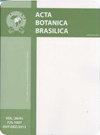Contact with natural areas influences Brazilian high school students’ ability to recognize native plant species
IF 1.1
4区 生物学
Q4 PLANT SCIENCES
引用次数: 0
Abstract
Limited experiential contact to natural environment can affect the knowledge of the local flora and, consequently, the intentions to conserve it. Therefore, this study aims to analyze whether high school students from Teresina (PI-Brazil) can identify more species of native than exotic plants and the factors that can affect this ability. 333 students from state public schools were interviewed through semi-structured questionnaires and with printed images of 20 species of plants found in the region. The data were analyzed using univariate non-parametric statistics. The results show that living in the countryside positively influenced the identification of local flora, but there was no significant difference in the number of identified plants between students who attended botany classes and those who did not. Two native plants (cashew-96.7% and pitomba-91.9%) and three exotic plants (mango-90.7%, guava-94.9% and acerola-82.0%) stood out among the most identified plant species. It was also found that, for two species of native plants very important for the State of Piauí, the caneleiro (0.6%) and the carnauba (26.7%), the identification rates were scarce. Thus, it is necessary to use Environmental Education and the teaching of Botany to prioritize native plant species, valuing local ecology and ensuring their protection.与自然区域的接触影响了巴西高中生识别本地植物物种的能力
与自然环境有限的经验接触会影响对当地植物群的认识,从而影响保护它们的意图。因此,本研究旨在分析来自Teresina (PI-Brazil)的高中生是否能够识别更多的本地植物种类,以及影响这种能力的因素。来自公立学校的333名学生接受了半结构化的问卷调查,并获得了该地区发现的20种植物的图片。数据分析采用单变量非参数统计。结果表明,生活在农村对当地植物的识别有积极的影响,但在识别植物的数量上,上过植物学课的学生与没有上过植物学课的学生没有显著差异。2种本地植物(腰果96.7%、皮桐91.9%)和3种外来植物(芒果90.7%、番石榴94.9%、针叶树82.0%)的鉴定率最高。此外,对于Piauí国家重要的原生植物caneleiro(0.6%)和carnauba(26.7%),鉴定率很低。因此,有必要利用环境教育和植物学教学来优先考虑本地植物物种,重视当地生态并确保其保护。
本文章由计算机程序翻译,如有差异,请以英文原文为准。
求助全文
约1分钟内获得全文
求助全文
来源期刊

Acta Botanica Brasilica
PLANT SCIENCES-
CiteScore
2.30
自引率
9.10%
发文量
32
审稿时长
6-12 weeks
期刊介绍:
Experimental, theoretical and applied papers on all aspects of plant (including algae) and fungi biology are welcome. The submitted manuscript or its essential content must not have been published previously or be under consideration for publication elsewhere. Contributions should be substantial, written in high-quality English and show general interest. We expect that the submitted manuscript presents a great novelty in Botany, and this should attract a wide audience. Considering this, case studies are only considered if the narrative and implications are provided to be of general interest. Thus, manuscripts that report aspects of local interest are discouraged unless the implications of the findings are wide-reaching. Manuscripts with agronomic subjects are expected to contain a substantial amount of basic plant biology. Please see below some details for specific area.
 求助内容:
求助内容: 应助结果提醒方式:
应助结果提醒方式:


